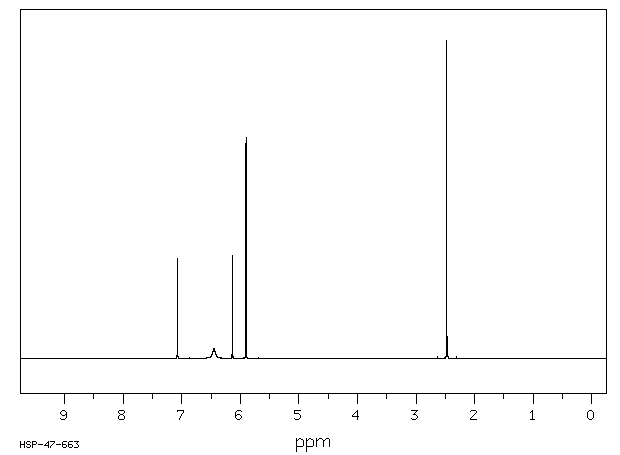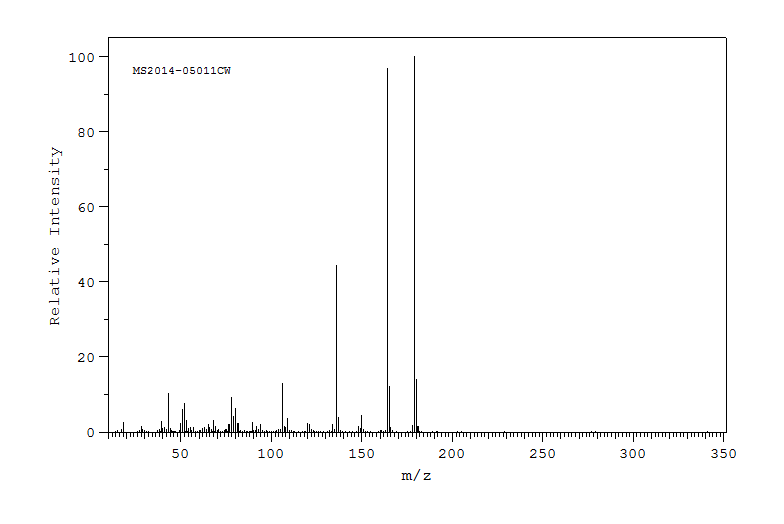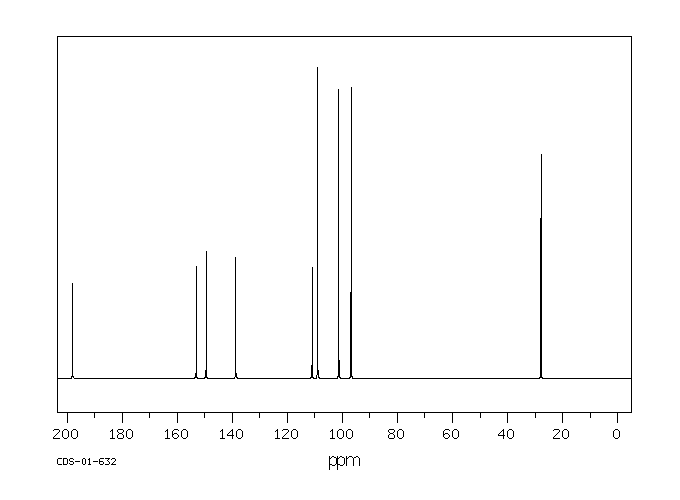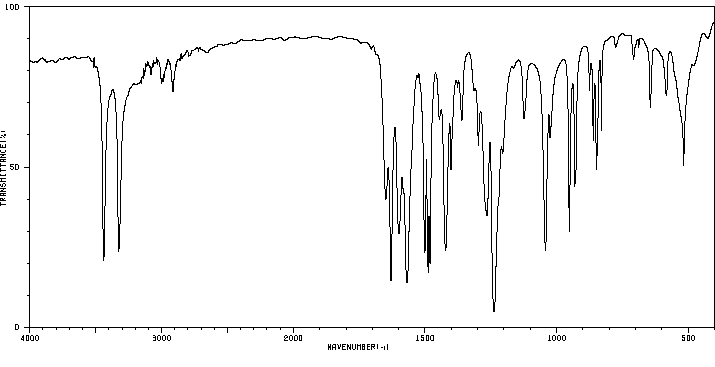2'-氨基-4',5'-亚甲二氧基苯乙酮 | 28657-75-2
分子结构分类
中文名称
2'-氨基-4',5'-亚甲二氧基苯乙酮
中文别名
6-氨基-3,4-亚甲二氧基苯乙酮;6'-氨基-3',4'-(亚甲基二氧代)苯乙酮;5-乙酰-6-氨基-1,3-苯并二呋喃;2’-氨基-4’,5’-亚甲二氧基苯乙酮;2-氨基-4,5-亚甲二氧基苯乙酮
英文名称
2-amino-4,5-methylenedioxy-acetophenone
英文别名
6-amino-3,4-methylenedioxyacetophenone;1-(6-aminobenzo[d][1,3]dioxol-5-yl)ethanone;1-(6-aminobenzo[d][1,3]dioxol-5-yl)ethan-1-one;1-(6-amino-1,3-benzodioxol-5-yl)ethanone
CAS
28657-75-2
化学式
C9H9NO3
mdl
MFCD00075855
分子量
179.175
InChiKey
DWTHYSZSRJOMSC-UHFFFAOYSA-N
BEILSTEIN
——
EINECS
——
-
物化性质
-
计算性质
-
ADMET
-
安全信息
-
SDS
-
制备方法与用途
-
上下游信息
-
文献信息
-
表征谱图
-
同类化合物
-
相关功能分类
-
相关结构分类
物化性质
-
熔点:168-171 °C
-
沸点:158 °C (30 mmHg)
-
密度:1.2822 (rough estimate)
-
溶解度:溶于二甲基甲酰胺
-
稳定性/保质期:
常温常压下稳定。
计算性质
-
辛醇/水分配系数(LogP):1.3
-
重原子数:13
-
可旋转键数:1
-
环数:2.0
-
sp3杂化的碳原子比例:0.222
-
拓扑面积:61.6
-
氢给体数:1
-
氢受体数:4
安全信息
-
危险品标志:Xn
-
安全说明:S26,S37/39
-
危险类别码:R22,R36/37/38
-
海关编码:2932999099
-
危险性防范说明:P264,P280,P302+P352+P332+P313+P362+P364,P305+P351+P338+P337+P313
-
危险性描述:H315,H319
-
储存条件:请将贮藏器密封存放于阴凉、干燥处,并确保工作环境具备良好通风或排气设施。
SDS
| Name: | 6-Amino-3 4-Methylenedioxyacetophenone 99+% (GC) Material Safety Data Sheet |
| Synonym: | None known |
| CAS: | 28657-75-2 |
Synonym:None known
Section 2 - COMPOSITION, INFORMATION ON INGREDIENTS
| CAS# | Chemical Name | content | EINECS# |
| 28657-75-2 | 6-Amino-3,4-Methylenedioxyacetophenone | 99+ | 249-131-7 |
Risk Phrases: None Listed.
Section 3 - HAZARDS IDENTIFICATION
EMERGENCY OVERVIEW
The toxicological properties of this material have not been fully investigated.
Potential Health Effects
Eye:
May cause eye irritation.
Skin:
May cause skin irritation.
Ingestion:
May cause irritation of the digestive tract. The toxicological properties of this substance have not been fully investigated.
Inhalation:
May cause respiratory tract irritation. The toxicological properties of this substance have not been fully investigated.
Chronic:
No information found.
Section 4 - FIRST AID MEASURES
Eyes: Flush eyes with plenty of water for at least 15 minutes, occasionally lifting the upper and lower eyelids. Get medical aid.
Skin:
Get medical aid. Flush skin with plenty of water for at least 15 minutes while removing contaminated clothing and shoes. Wash clothing before reuse.
Ingestion:
Never give anything by mouth to an unconscious person. Get medical aid. Do NOT induce vomiting. If conscious and alert, rinse mouth and drink 2-4 cupfuls of milk or water.
Inhalation:
Remove from exposure and move to fresh air immediately. If not breathing, give artificial respiration. If breathing is difficult, give oxygen. Get medical aid.
Notes to Physician:
Section 5 - FIRE FIGHTING MEASURES
General Information:
As in any fire, wear a self-contained breathing apparatus in pressure-demand, MSHA/NIOSH (approved or equivalent), and full protective gear. During a fire, irritating and highly toxic gases may be generated by thermal decomposition or combustion.
Extinguishing Media:
Use agent most appropriate to extinguish fire. Use water spray, dry chemical, carbon dioxide, or appropriate foam.
Section 6 - ACCIDENTAL RELEASE MEASURES
General Information: Use proper personal protective equipment as indicated in Section 8.
Spills/Leaks:
Clean up spills immediately, observing precautions in the Protective Equipment section. Sweep up, then place into a suitable container for disposal. Avoid generating dusty conditions. Provide ventilation.
Section 7 - HANDLING and STORAGE
Handling:
Wash thoroughly after handling. Remove contaminated clothing and wash before reuse. Use with adequate ventilation. Minimize dust generation and accumulation. Avoid contact with eyes, skin, and clothing. Keep container tightly closed. Avoid ingestion and inhalation.
Storage:
Store in a tightly closed container. Store in a cool, dry, well-ventilated area away from incompatible substances.
Section 8 - EXPOSURE CONTROLS, PERSONAL PROTECTION
Engineering Controls:
Facilities storing or utilizing this material should be equipped with an eyewash facility and a safety shower. Use adequate ventilation to keep airborne concentrations low.
Exposure Limits CAS# 28657-75-2: Personal Protective Equipment Eyes: Wear appropriate protective eyeglasses or chemical safety goggles as described by OSHA's eye and face protection regulations in 29 CFR 1910.133 or European Standard EN166.
Skin:
Wear appropriate protective gloves to prevent skin exposure.
Clothing:
Wear appropriate protective clothing to prevent skin exposure.
Respirators:
A respiratory protection program that meets OSHA's 29 CFR 1910.134 and ANSI Z88.2 requirements or European Standard EN 149 must be followed whenever workplace conditions warrant respirator use.
Section 9 - PHYSICAL AND CHEMICAL PROPERTIES
Physical State: Crystalline powder
Color: brown
Odor: None reported.
pH: Not available.
Vapor Pressure: Not available.
Viscosity: Not available.
Boiling Point: Not available.
Freezing/Melting Point: 168.00 - 171.00 deg C
Autoignition Temperature: Not applicable.
Flash Point: Not applicable.
Explosion Limits, lower: Not available.
Explosion Limits, upper: Not available.
Decomposition Temperature:
Solubility in water:
Specific Gravity/Density:
Molecular Formula: C9H9NO3
Molecular Weight: 179.18
Section 10 - STABILITY AND REACTIVITY
Chemical Stability:
Stable under normal temperatures and pressures.
Conditions to Avoid:
Incompatible materials, dust generation, excess heat, strong oxidants.
Incompatibilities with Other Materials:
Oxidizing agents.
Hazardous Decomposition Products:
Nitrogen oxides, carbon monoxide, irritating and toxic fumes and gases, carbon dioxide.
Hazardous Polymerization: Has not been reported.
Section 11 - TOXICOLOGICAL INFORMATION
RTECS#:
CAS# 28657-75-2 unlisted.
LD50/LC50:
Not available.
Carcinogenicity:
6-Amino-3,4-Methylenedioxyacetophenone - Not listed by ACGIH, IARC, or NTP.
Section 12 - ECOLOGICAL INFORMATION
Section 13 - DISPOSAL CONSIDERATIONS
Dispose of in a manner consistent with federal, state, and local regulations.
Section 14 - TRANSPORT INFORMATION
IATA
Not regulated as a hazardous material.
IMO
Not regulated as a hazardous material.
RID/ADR
Not regulated as a hazardous material.
Section 15 - REGULATORY INFORMATION
European/International Regulations
European Labeling in Accordance with EC Directives
Hazard Symbols: Not available.
Risk Phrases:
Safety Phrases:
S 24/25 Avoid contact with skin and eyes.
S 28A After contact with skin, wash immediately with
plenty of water.
S 37 Wear suitable gloves.
S 45 In case of accident or if you feel unwell, seek
medical advice immediately (show the label where
possible).
WGK (Water Danger/Protection)
CAS# 28657-75-2: No information available.
Canada
None of the chemicals in this product are listed on the DSL/NDSL list.
CAS# 28657-75-2 is not listed on Canada's Ingredient Disclosure List.
US FEDERAL
TSCA
CAS# 28657-75-2 is not listed on the TSCA inventory.
It is for research and development use only.
SECTION 16 - ADDITIONAL INFORMATION
N/A
上下游信息
-
上游原料
中文名称 英文名称 CAS号 化学式 分子量 4',5'-亚甲基二氧-2'-硝基苯乙酮 4',5'-methylenedioxy-2'-nitroacetophenone 56136-84-6 C9H7NO5 209.158 3,4-亚甲二氧苯乙酮 1-(benzo[d][1,3]dioxol-6-yl)ethanone 3162-29-6 C9H8O3 164.161 6-氨基-1,3-苯并二氧戊环-5-甲腈 5-amino-6-cyanobenzo <1,3>dioxale 187164-87-0 C8H6N2O2 162.148 —— N-(6-acetylbenzo[d][1,3]dioxol-5-yl)-4-methylbenzenesulfonamide 460994-52-9 C16H15NO5S 333.365 -
下游产品
中文名称 英文名称 CAS号 化学式 分子量 1-(6-氨基-1,3-苯并二氧戊环-5-基)-2-氯乙烷酮 2'-amino-2-chloro-4',5'-(methylenedioxy)acetophenone 149809-26-7 C9H8ClNO3 213.62 —— 1-(6-azidobenzo[d][1,3]dioxol-5-yl)ethanone 244245-71-4 C9H7N3O3 205.173 —— N-(6-acetyl-1,3-benzodioxol-5-yl)formamide 76787-21-8 C10H9NO4 207.186 —— 1-(6-amino-1,3-benzodioxol-5-yl)-3-(4-methoxyphenyl)prop-2-en-1-one —— C17H15NO4 297.31 —— 1-(6-amino-1,3-benzodioxol-5-yl)-3-(4-methylphenyl)prop-2-en-1-one —— C17H15NO3 281.311 —— (E)-1-(6-Amino-benzo[1,3]dioxol-5-yl)-3-(3-methoxy-phenyl)-propenone 204841-35-0 C17H15NO4 297.31 —— 1-(6-amino-1,3-benzodioxol-5-yl)-3-(4-pyridyl)prop-2-en-1-one 945868-98-4 C15H12N2O3 268.272 —— 1-(6-amino-1,3-benzodioxol-5-yl)-3-[4-(trifluoromethyl)phenyl]prop-2-en-1-one 843659-64-3 C17H12F3NO3 335.282 —— 1-(6-amino-1,3-benzodioxol-5-yl)-3-(3,4,5-trimethoxyphenyl)prop-2-en-1-one 421766-44-1 C19H19NO6 357.363 —— 1-(6-aminobenzo[d][1,3]dioxol-5-yl)-3-(4-nitrophenyl)prop-2-en-1-one 1087269-37-1 C16H12N2O5 312.282 N-(6-乙酰基-1,3-苯并二氧杂环戊烯-5-基)-2-氯乙酰胺 2'-acetyl-2-chloro-4',5'-methylenedioxyacetanilide 85590-94-9 C11H10ClNO4 255.658 —— 2-[N-carbethoxyamino]-4,5-methylenedioxyacetophenone 98216-16-1 C12H13NO5 251.239 —— N-(6-acetylbenzo[d][1,3]dioxol-5-yl)benzamide 903297-11-0 C16H13NO4 283.284 —— (E)-N-(6-acetyl-1,3-benzodioxol-5-yl)-3-phenylprop-2-enamide —— C18H15NO4 309.321 —— N-(6-acetyl-1,3-benzodioxol-5-yl)cyclohexanecarboxamide —— C16H19NO4 289.331 —— 2'-acetyl-2-benzylamino-4',5'-methylenedioxyacetanilide 85590-96-1 C18H18N2O4 326.352 —— N-(6-acetyl-1,3-benzodioxol-5-yl)-4-methylbenzamide —— C17H15NO4 297.31 —— N-(6-Acetyl-benzo[1,3]dioxol-5-yl)-3-methoxy-benzamide —— C17H15NO5 313.31 —— N-(6-Acetyl-benzo[1,3]dioxol-5-yl)-4-chloro-benzamide —— C16H12ClNO4 317.729 —— N-(6-acetyl-1,3-benzodioxol-5-yl)-3-aminobenzamide 1027034-28-1 C16H14N2O4 298.298 —— N-(6-acetyl-1,3-benzodioxol-5-yl)-3-methylbenzamide —— C17H15NO4 297.31 —— N-(6-acetyl-1,3-benzodioxol-5-yl)-2-(naphthalen-1-yl)acetamide 723255-79-6 C21H17NO4 347.37 —— N-(6-acetyl-1,3-benzodioxol-5-yl)naphthalene-2-carboxamide 903354-53-0 C20H15NO4 333.343 —— N-(6-acetyl-1,3-benzodioxol-5-yl)-4-tert-butylbenzamide —— C20H21NO4 339.391 —— N-(6-acetyl-1,3-benzodioxol-5-yl)-2-methylbenzamide —— C17H15NO4 297.31 —— N-(6-acetylbenzo[d][1,3]dioxol-5-yl)thiophene-3-carboxamide 1240861-50-0 C14H11NO4S 289.312 —— N-(6-acetyl-1,3-benzodioxol-5-yl)-3-bromobenzamide —— C16H12BrNO4 362.18 —— N-(6-acetylbenzo[d][1,3]dioxol-5-yl)-4-(benzyloxy)benzamide 874010-49-8 C23H19NO5 389.408 —— N-(6-acetylbenzo[d][1,3]dioxol-5-yl)selenophene-3-carboxamide 1350903-40-0 C14H11NO4Se 336.206 —— N-(6-acetyl-1,3-benzodioxol-5-yl)-3-chlorobenzenecarboxamide —— C16H12ClNO4 317.729 —— N-(6-acetylbenzo[d][1,3]dioxol-5-yl)furan-3-carboxamide 1324271-28-4 C14H11NO5 273.245 —— N-(6-Acetyl-benzo[1,3]dioxol-5-yl)-3-fluoro-benzamide —— C16H12FNO4 301.274 —— N-(6-acetylbenzo[d][1,3]dioxol-5-yl)-2-(4-benzylpiperazin-1-yl)acetamide —— C22H25N3O4 395.458 —— N-(6-acetyl-1,3-benzodioxol-5-yl)-3-phenylmethoxybenzamide 1181093-11-7 C23H19NO5 389.408 —— N-(6-Acetyl-benzo[1,3]dioxol-5-yl)-2-fluoro-benzamide 666818-14-0 C16H12FNO4 301.274 —— N-(6-acetyl-1,3-benzodioxol-5-yl)naphthalene-1-carboxamide 1177265-94-9 C20H15NO4 333.343 —— N-(6-acetylbenzo[d][1,3]dioxol-5-yl)selenophene-2-carboxamide 1032315-83-5 C14H11NO4Se 336.206 —— N-(6-acetylbenzo[d][1,3]dioxol-5-yl)furan-2-carboxamide 460994-42-7 C14H11NO5 273.245 —— N-(6-acetylbenzo[d][1,3]dioxol-5-yl)thiophene-2-carboxamide 460994-43-8 C14H11NO4S 289.312 —— N-(6-acetyl-1,3-benzodioxol-5-yl)-2-methoxybenzamide —— C17H15NO5 313.31 —— N-(6-acetylbenzo[d][1,3]dioxol-5-yl)-4-methylbenzenesulfonamide 460994-52-9 C16H15NO5S 333.365 —— N-(6-acetyl-1,3-benzodioxol-5-yl)-3-(trifluoromethyl)benzamide —— C17H12F3NO4 351.282 —— N-(6-acetyl-1,3-benzodioxol-5-yl)anthracene-1-carboxamide 1177265-98-3 C24H17NO4 383.403 —— N-(6-acetylbenzo[d][1,3]dioxol-5-yl)-3'-(benzoxy)-5'-methoxy-benzamide 1355235-78-7 C24H21NO6 419.434 —— 1-(1,3-Benzodioxol-5-yl)-3-[4-(dimethylamino)phenyl]prop-2-en-1-one 828275-16-7 C18H17NO3 295.338 —— N-(6-acetyl-1,3-benzodioxol-5-yl)-3-nitrobenzamide 178983-58-9 C16H12N2O6 328.281 —— N-(6-acetyl-1,3-benzodioxol-5-yl)-3-ethoxy-5-phenylmethoxybenzamide 1452587-53-9 C25H23NO6 433.461 —— N-(6-acetylbenzo[d][1,3]dioxol-5-yl)-5-methylfuran-2-carboxamide 848582-24-1 C15H13NO5 287.272 —— 1-(1,3-Benzodioxol-5-yl)-3-(4-bromophenyl)-2-propen-1-one 756826-07-0 C16H11BrO3 331.166 —— N-(6-acetylbenzo[d][1,3]dioxol-5-yl)-5-methylthiophene-2-carboxamide 1061904-67-3 C15H13NO4S 303.339 —— 6-(3-Methoxy-phenyl)-6,7-dihydro-5H-[1,3]dioxolo[4,5-g]quinolin-8-one 204841-50-9 C17H15NO4 297.31 —— 1-(6-iodobenzo[d][1,3]dioxol-5-yl)ethanone 61599-79-9 C9H7IO3 290.057 —— 3,4,5-Trimethoxy-3',4'-methylenedioxy chalcone 75403-98-4 C19H18O6 342.348 —— N-(6-acetyl-1,3-benzodioxol-5-yl)quinoline-2-carboxamide 1061887-07-7 C19H14N2O4 334.331 —— 6-(3-Fluoro-phenyl)-6,7-dihydro-5H-[1,3]dioxolo[4,5-g]quinolin-8-one —— C16H12FNO3 285.275 —— N-(6-acetyl-1,3-benzodioxol-5-yl)-quinoline-3-carboxamide 1177265-96-1 C19H14N2O4 334.331 —— N-(6-acetyl-1,3-benzodioxol-5-yl)quinoline-4-carboxamide 1177265-95-0 C19H14N2O4 334.331 —— N-(6-acetyl-1,3-benzodioxol-5-yl)quinoline-5-carboxamide 1177265-97-2 C19H14N2O4 334.331 —— 6-(2-Fluoro-phenyl)-6,7-dihydro-5H-[1,3]dioxolo[4,5-g]quinolin-8-one 204841-45-2 C16H12FNO3 285.275 —— N-(6-acetyl-1,3-benzodioxol-5-yl)-1-benzofuran-2-carboxamide 903335-01-3 C18H13NO5 323.305 —— N-(6-acetyl-1,3-benzodioxol-5-yl)-1-benzothiophene-2-carboxamide 1177265-92-7 C18H13NO4S 339.372 —— N-(6-acetyl-1,3-benzodioxol-5-yl)-1-benzothiophene-3-carboxamide 1177265-91-6 C18H13NO4S 339.372 —— N-(6-acetylbenzo[d][1,3]dioxol-5-yl)-2-(1-(furan-3-carbonyl)piperidin-3-yl)acetamide —— C21H22N2O6 398.415 —— N-(6-acetyl-1,3-benzodioxol-5-yl)-1-benzofuran-3-carboxamide 1177265-93-8 C18H13NO5 323.305 - 1
- 2
- 3
- 4
- 5
- 6
- 7
反应信息
-
作为反应物:描述:2'-氨基-4',5'-亚甲二氧基苯乙酮 在 钯 palladium diacetate 、 甲酸 、 sodium hydride 、 溶剂黄146 、 三乙胺 、 三(邻甲基苯基)磷 、 silver carbonate 、 三氯氧磷 、 苯酚 作用下, 以 二氯甲烷 、 N,N-二甲基甲酰胺 为溶剂, 反应 42.5h, 生成 GENZ-644282抑制剂参考文献:名称:5-(2-Aminoethyl)dibenzo[c,h][1,6]naphthyridin-6-ones: Variation of N-Alkyl Substituents Modulates Sensitivity to Efflux Transporters Associated with Multidrug Resistance摘要:5H-8,9-Dimethoxy-5-(2-N,N-dimethylaminoethyl)-2,3-methylenedioxydibenzo [c, h]-[1,6]naphthyridin-6-one (ARC-111) has potent TOP1-targeting activity and pronounced antitumor activity. Several analogues of ARC-111 were synthesized with NH2, N-alkyl, N,N-dialkyl, pyrrolidinyl, piperidinyl, and piperazinyl substituents at the 2-position of the 5-ethyl group. The relative TOP1-targeting activity and cytotoxicity of these structural analogues were assessed in RPMI8402 and P388 tumor cells and their camptothecin-resistant variants CPT-K5 and P388/CPT45, respectively. Potent TOP1-targeting activity was retained within a series of mono N-alkyl analogues that included NHCH2CH3, NHCH(CH3)(2), and NHC(CH3)(3). TOP1-targeting activity was diminished by the presence of a N-benzyl moiety. In a comparison of a series of N-alkyl-N-isopropyl analogues, activity decreased in the order CH3 > CH2CH3 > CH(CH3)(2). Cytotoxicity in RPMI8402 and P388 did correlate with TOP1-targeting activity. Cytotoxic activity was also determined in KB3-1 cells and its variants KB/V-1 and KBH5.0. As KB/V-1 cells overexpress MDR1 and KBH5.0 cells overexpress BCRP, decreased cytotoxicity in these cell lines relative to the parent cell line is indicative of compounds that are substrates for these efflux transporters. In view of their diminished cytotoxicity in KB/V-1 cells, it appears that the likely demethylated metabolites of ARC-111, i.e., where NH2 or NHCH3 replaces the N(CH3)(2) at the 2-position of the 5-ethyl substituent, are substrates for MDR1. In contrast, no significant difference in cytotoxicity among these three cell lines was observed with other N-alkyl analogues, including NHC2H5, NHCH(CH3)(2), NHC(CH3)(3), N(CH3)(2), N(CH2CH3)(2), NCH3(CH(CH)(3))(2)), and either the pyrrolidinyl or the piperidinyl analogues. The 2-(piperazinyl) analogues were associated with diminished cytotoxicity in KB/V-1 cells, suggesting that the second basic amino substituent is associated with their recognition as substrates by MDR1. Comparative studies on the antitumor activity of ARC-111 and its N-demethylated derivatives (the NHCH3 and NH2 analogues) against SJ-BT45 medulloblastoma xenografts in scid mice revealed that the secondary amine metabolite is at least as active as ARC-111 in vivo, although the primary amine derivative was significantly less potent.DOI:10.1021/jm049447z
-
作为产物:描述:3,4-亚甲二氧苯乙酮 在 palladium 10% on activated carbon 、 氢气 、 硝酸 作用下, 以 硝基甲烷 、 乙醇 为溶剂, 反应 18.5h, 生成 2'-氨基-4',5'-亚甲二氧基苯乙酮参考文献:名称:[EN] CAMPTOTHECIN DERIVATIVE, AND PHARMACEUTICAL COMPOSITION AND USE THEREOF
[FR] DÉRIVÉ DE CAMPTOTHÉCINE, COMPOSITION PHARMACEUTIQUE ET LEUR UTILISATION
[ZH] 喜树碱衍生物、其药物组合物及其应用摘要:提供了式(I)所示化合物、或其立体异构体或药学上可接受的盐、其药物组合物,以及它们在抗肿瘤方面的用途。公开号:WO2023020605A1
文献信息
-
Ru(ii)-catalyzed intermolecular ortho-C–H amidation of aromatic ketones with sulfonyl azides作者:M. Bhanuchandra、M. Ramu Yadav、Raja K. Rit、Malleswara Rao Kuram、Akhila K. SahooDOI:10.1039/c3cc41915k日期:——Ru(II)-catalyzed intermolecular ortho-CâH amidation of weakly coordinating aromatic ketones with sulfonyl azides is reported. The developed reaction protocol can be extended to various substituted aromatic ketones to afford a wide range of desired CâN bond formation products in good yields.
-
Conversion of Aromatic Amino into Trifluoromethyl Groups through a Sandmeyer-Type Transformation作者:Jianbo Wang、Xi Wang、Yan Xu、Yujing Zhou、Yan ZhangDOI:10.1055/s-0033-1338659日期:——strategy for aromatic trifluoromethylation by converting amino into trifluoromethyl groups via a Sandmeyer-type reaction is reported. The transformation involves diazotization of the aromatic amines with tert-butyl nitrite and hydrochloric acid to form aryldiazonium chlorides, followed by trifluoromethylation with trifluoromethylsilver at low temperature. Various readily available aromatic amines are
-
Biphenylsulfonamides and derivatives thereof that modulate the activity of endothelin申请人:——公开号:US20020095041A1公开(公告)日:2002-07-18Biphenylsulfonamides and methods for modulating or altering the activity of the endothelin family of peptides are provided. In particular, bicyclic or tricyclic carbon or heterocyclic ring biphenylsulfonamides and methods using these sulfonamides for inhibiting the binding of an endothelin peptide to an endothelin receptor by contacting the receptor with the sulfonamide are provided. Methods for treating endothelin-mediated disorders by administering effective amounts of one or more of these sulfonamides or prodrugs thereof that inhibit or increase the activity of endothelin are also provided.
-
Easy α-alkylation of ketones with alcohols through a hydrogen autotransfer process catalyzed by RuCl2(DMSO)4作者:Ricardo Martínez、Diego J. Ramón、Miguel YusDOI:10.1016/j.tet.2006.07.013日期:2006.9indicate that the process goes through the oxidation of the alcohols with ruthenium (after a previous deprotonation) to yield the corresponding aldehyde and a ruthenium hydride intermediate. In turn, the aldehyde suffers a classical aldol reaction with the starting ketone to form the corresponding α,β-unsaturated ketone, which finally is reduced through a Michael-type addition by the aforementioned ruthenium
-
Synthesis of the antitumoural agent batracylin and related isoindolo[1,2-b]quinazolin-12(10H)-ones作者:Carlos M. Martínez-Viturro、Domingo DomínguezDOI:10.1016/j.tetlet.2006.11.168日期:2007.2The synthesis of batracylin and related isoindolo[1,2-b]quinazolin-12-ones from easily accessible o-acylanilines is reported. The preparation of these tetracyclic compounds through a Mitsunobu reaction followed by spontaneous cyclodehydration shows the ability of this methodology to afford good yields of a wide variety of diversely 7, 8, 9, 10-substituted isoindoloquinazolinones in two steps.
表征谱图
-
氢谱1HNMR
-
质谱MS
-
碳谱13CNMR
-
红外IR
-
拉曼Raman
-
峰位数据
-
峰位匹配
-
表征信息
同类化合物
(5-(4-乙氧基-3-甲基苄基)-1,3-苯并二恶茂)
黄樟素氧化物
黄樟素乙二醇; 2',3'-二氢-2',3'-二羟基黄樟素
黄樟素
风藤酰胺
风藤酮
非哌西特盐酸盐
非哌西特 盐酸盐
角秋水仙碱
螺[1,3-苯并二氧戊环-2,1'-环己烷]-5-胺
蓝细菌
苯并[d][1,3]二氧杂环戊烯-5-胺盐酸盐
苯并[d][1,3]二氧代l-5-甲基(2-氧代乙基)氨基甲酸叔丁酯
苯并[d][1,3]二氧代l-5-氨基甲酸叔丁酯
苯并[d][1,3]二氧代-4-甲腈
苯并[d][1,3]二氧代-4-氨基甲酸叔丁酯
苯并[d[1,3]二氧代-4-羧酰胺
苯并[1,3]二氧杂环戊烯-5-基甲基2-氯乙酸酯
苯并[1,3]二氧杂环戊烯-5-基甲基-苄基-胺
苯并[1,3]二氧杂环戊烯-5-基甲基-[2-(4-氟-苯基)-乙基]-胺
苯并[1,3]二氧杂环戊烯-5-基甲基-(四氢-呋喃-2-基甲基)-胺
苯并[1,3]二氧杂环戊烯-5-基甲基-(2-氟-苄基)-胺
苯并[1,3]二氧杂环戊烯-5-基甲基-(1-甲基-哌啶-4-基)-胺
苯并[1,3]二氧代l-5-甲基-吡啶-3-甲基-胺
苯并[1,3]二氧代l-5-甲基-(4-氟-苄基)-胺
苯并[1,3]二氧代l-5-乙酸甲酯
苯并[1,3]二氧代-5-羧酰胺盐酸盐
苯并[1,3]二氧代-5-甲基肼盐酸盐
苯并[1,3]二氧代-5-甲基吡啶-4-甲胺
苯并[1,3]二氧代-5-甲基-吡啶-2-甲胺
苯并[1,3]二氧代-5-乙酰氯
苯并-1,3-二氧杂环戊烯-5-甲醇丙酸酯
苯乙酸,1-(1,3-苯并二氧杂环戊烯-5-基)-3-丁烯-1-基酯
苯乙酮O-((4-(3,4-亚甲二氧基苄基)-1-哌嗪-1-基)羰基甲基)肟
苯,1-甲氧基-6-硝基-3,4-亚甲二氧基-
芝麻酚
芝麻林素
脲,N-1,3-苯并二噁唑-5-基-N'-(2-溴乙基)-
胡椒醛肟
胡椒醛-((Z)-O-苯基氨基甲酰基肟)
胡椒醛,二苄基缩硫醛
胡椒醛
胡椒醇
胡椒酸酰氯
胡椒酸
胡椒腈
胡椒环乙酮肟
胡椒环
胡椒基重氮酮
胡椒基甲醛










